The argument can be made that the toughest environment for a flexible circuit boards is the prototyping phase of the design development. During this process, the circuit is potentially installed and removed multiple times as the form, fit, and function are evaluated and qualified. There’s the opportunity for the flex circuit to be inadvertently mishandled, dropped, bent beyond the design limits, etc.
We have seen many designs that experience a significant amount of fallout during prototyping, but once it goes into production, the issues disappear. In production, a trained technician installs the flexible PCB once following a documented procedure and the part performs with 100% reliability.
In this blog, we will review some of the more common failure mechanisms encountered during prototyping flexible circuit boards.
ZIF Connectors
Flex PCB designs that plug into ZIF connectors can easily be broken if mishandled. A common occurrence is not having the latching mechanism of the ZIF connector fully open prior to inserting the flex. This causes excess force to be applied to the flex during insertion. This can then result in the flex bending/kinking at the point where the coverlay terminates at the exposed Electroless Nickel Immersion Gold (ENIG) coated finger area. The ENIG surface finish is inherently brittle due to the nickel layer.
If bent, the nickel will crack, and that creates a significant mechanical stress concentration on the underlying copper, which then also cracks. The part now has an intermittent open.
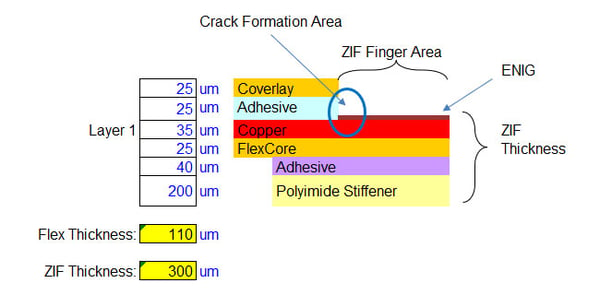
Example of ZIF contact area and crack formation area.

Example of flexible PCB ZIF connector area.
In addition, extracting a flex without fully opening the latching mechanism will result in scratched contact fingers, potential intermittent contact, and the chance of ripping the flex circuit.
Rigid PCB to Flex Transitions
Another significant potential failure location in a rigid-flex PCB design is the transition from a rigid area to a flexible section. Because of this change in the construction, and the hard edge created, the flex may be damaged if bent repeatedly and or sharply immediately against the rigid area. This will stress the flex materials beyond their physical capability, resulting in cracked circuits.
Rotating or prying the flex section, for example, in an effort to separate a connector may result in a tear developing at the corner. These transition area corners will always have a radius in the flex outline, but that only offers limited protection against the formation of a tear.
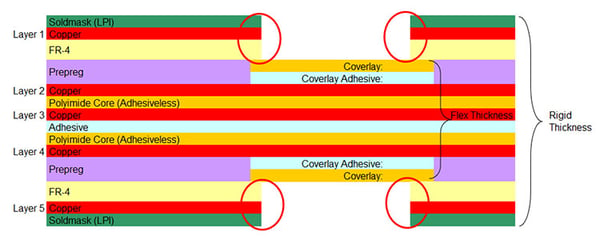
Example of a rigid-flex PCB stack-up illustrating rigid to flex transition areas.
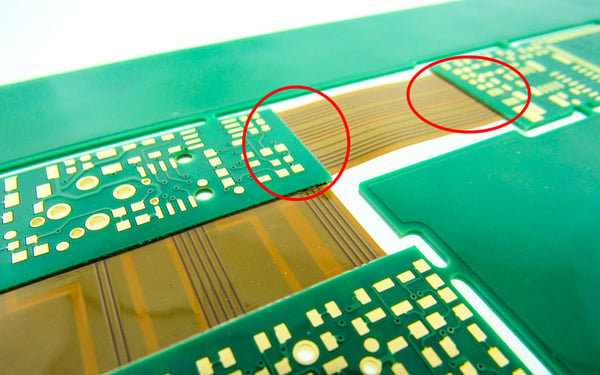
Example of a rigid-flex circuit board, rigid to flex transition areas.
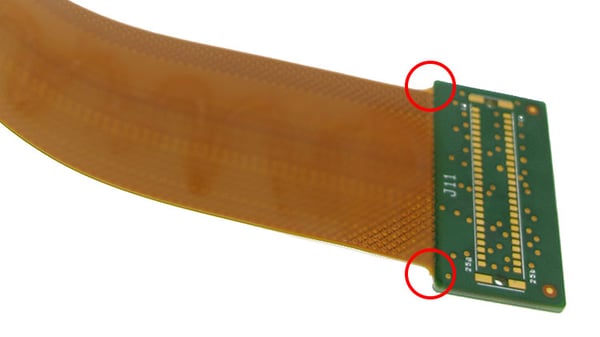
Example of a rigid-flex circuit board outlining transition corner radius.
A common optional addition to many designs is a flexible epoxy strain relief at the rigid to flex transition. This strain relief adds a significant amount of protection to the flex for designs that have tight bend requirements adjacent to the rigid area(s). However, the flex can still be damaged if abused.
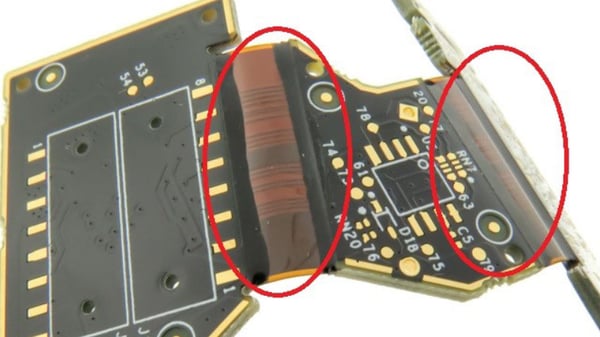
Example of a rigid-flex circuit board with epoxy strain relief.
Replacing Components
Replacing components on a flex only circuit can result in lifted and or torn SMT and PTH pads. Depending upon the flex core type used the copper is either adhered to the Polyimide core with a layer of adhesive or the Polyimide is cast on to the copper. With either configuration, an excessive or repeated application of soldering level temperatures may cause the copper pad to detach from the underlying adhesive or polyimide. Care must be taken not to overheat the solder joint(s) and not to repeatedly rework the same circuit.
Components in rigid areas of a rigid-flex design can typically absorb the same levels of abuse that a rigid only PCB can withstand.
.jpg?width=600&name=examples-of-assembled-flex-and-rigid-flex-pcbs%20(1).jpg)
Assembled flex and rigid-flex PCB examples.
Folded/Creased Flexible Circuit Designs
Many flexible circuit designs require convoluted shapes to fit into the final assembly. A significant benefit of flex circuits is the ability to design in folds to create the corners rather than laying out the shape in the data set. This allows the flex to be manufactured in a straight configuration, which optimizes the material usage and significantly reduces the part cost. IPC 2223 flex design standard allows for most 1- and 2-layer designs to be folded and hard creased, but with the provision that the fold be performed only once and not be re-opened.
Creasing a flex will take the copper circuitry beyond its level of ductility, causing the copper to work harden and become embrittled. At this point, the circuits are still intact and reliable. Re-opening / re-folding will cause the circuits to then crack.
Most folded designs have the added safety mechanism of a section of pressure sensitive adhesive (PSA) in the fold area that then prevents the flex from being opened. The added PSA may complicate the prototyping phase as the fit is evaluated and finalized. Adding the PSA only once the design goes into production is common. In most cases, fallout and breakage is expected during the prototype phase with the knowledge that in production, with the addition of the PSA, there will not be any issues.
Reliability Testing
IPC 2223 design standard covers the majority of elements in most flexible circuit board designs. However, flex technology allows for many creative applications that can fall outside of IPC recommendations.
For these types of designs, your flex PCB supplier should be able to provide support by identifying these design elements. Additional reliability testing will be necessary during the prototype phase as part of the design qualification. With the potential unknowns, fallout is to be expected during testing. For most designs, multiple variations can be manufactured in one prototype release to allow multiple configurations to be tested.
Summary
Flexible circuit board technology is very reliable and solves many mechanical design challenges. The prototyping phase requires parts to be fitted many times over to finalize form, fit, and function. This excessive handling, and potential inadvertent misuse, can cause parts to fail.
These failures require review to ensure that they do not impact production parts, but in many cases are not a true indication of the effectiveness and reliability of the design. The option of overengineering a design to make it more reliable during prototyping is typically not practical and will add unnecessary cost to the design.
Key Takeaways
- Prototype handling introduces the most failures: Unlike production, where trained technicians install once under controlled procedures, prototypes are repeatedly handled, inserted, and removed, leading to increased chances of damage.
- ZIF connector mishandling is a common failure mode: Improper insertion or removal without fully opening the latch stresses brittle ENIG-plated contacts, causing cracks in nickel and copper or scratched/ripped flex contacts.
- Rigid-to-flex transitions are high-risk areas: Sharp bends or prying near rigid-flex junctions can overstress the materials, leading to cracks or tears. Epoxy strain relief can improve reliability, but abuse can still cause damage.
- Rework and folding practices must be carefully controlled: Excessive soldering heat during component replacement can lift or tear pads, while repeatedly folding/creasing flex circuits beyond their ductility will cause copper cracking.
- Reliability testing is critical in prototypes: IPC 2223 provides guidelines, but creative flex designs often need extra qualification. Failures during prototyping are expected and should be evaluated separately from production reliability.

















